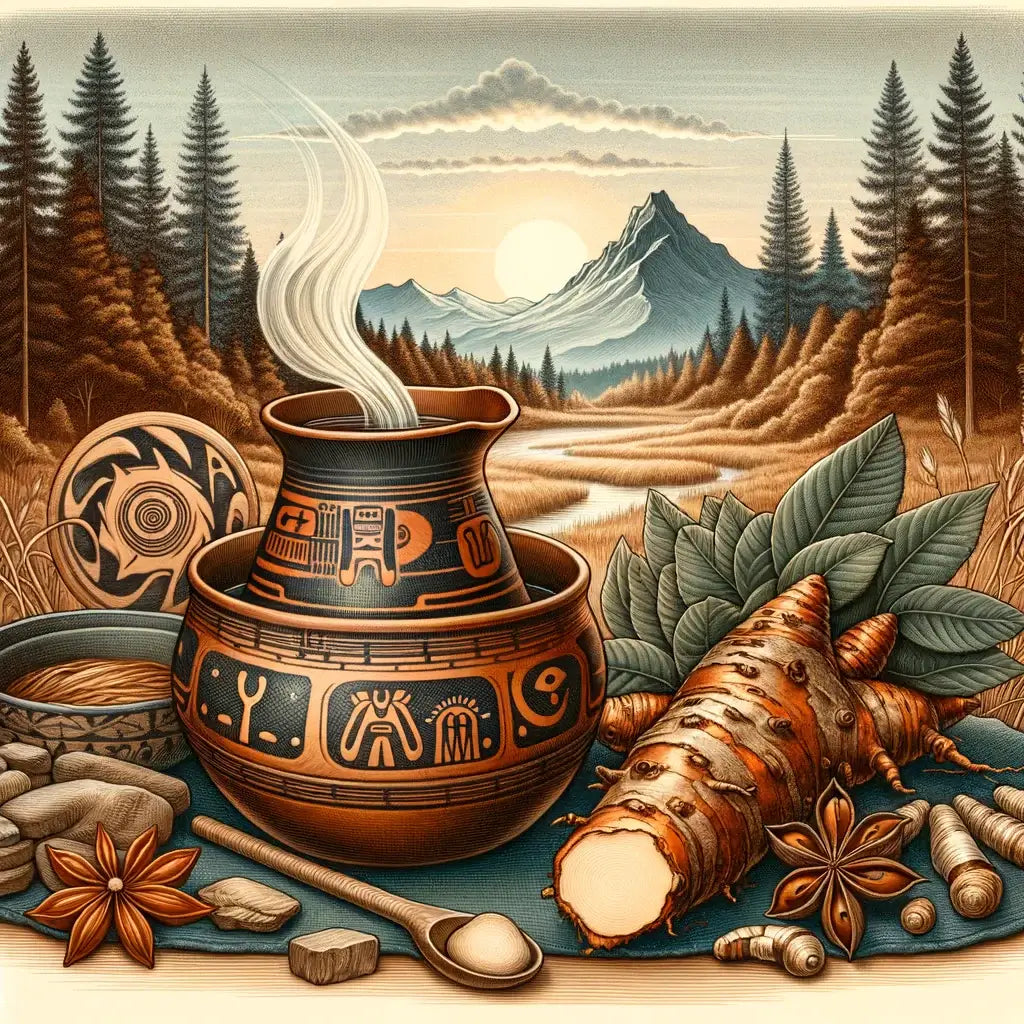Osha Root: Traditional Native Remedy for Seasonal Respiratory Wellness
Context & Care
This article shares historical uses and community practices around osha root (Ligusticum porteri). It is informational and not medical advice. Osha is not an approved treatment for flu, COVID-19, or any disease. If you have symptoms or take medications, consult a qualified healthcare professional before use.
We're exploring the story of osha root (Ligusticum porteri), a high-elevation plant long treasured in Native American and Hispano herbal traditions of the Southern Rockies and Southwest. Historically, it has been used in seasonal wellness routines, especially for breath and stamina, and often appears in cultural accounts as a winter ally. Interest in osha continues today. However, modern evidence varies by preparation and study design, and more well-controlled human trials are needed.

Osha Root (Bear Root)
Premium wildcrafted osha root from high-elevation ecosystems. Ethically sourced and used traditionally in seasonal wellness routines for respiratory comfort and stamina.
Explore This HerbHistorical and Cultural Significance of Osha Root
Osha's story is inseparable from place. In many Native American traditions, osha was prepared as a decoction or chewed in small amounts within seasonal wellness practices and ceremony. In Hispano herbal practice, "bear medicine" is a common folk name, echoing lore of animals seeking roots in early spring. These accounts are part of cultural heritage. They help us understand how communities relate to this plant, but they don't replace clinical guidance.
Understanding Osha's Sacred Context: Before working with osha root in wellness routines, we invite you to learn about its deeper cultural and spiritual significance. Read our guide: Exploring the Spiritual Uses of Osha Root.
Traditional Respiratory Support

Historical use in community settings: In many folk and community settings, especially across the Southern Rockies and high-desert Southwest, people turned to osha when the seasons shifted and dry air, smoke, dust, or winter chills made breathing feel less comfortable. A common pattern was a simple decoction: thin slices of root simmered gently and sipped warm, sometimes alongside ginger, mullein, or honey. Others chewed a small piece of the root or carried it while traveling in cold weather. These practices were about day-to-day comfort and ritual care for the breath, not quick cures.
Broader folk applications: Beyond seasonally focused use, historical notes and family recipes place osha in bitters, tonics, and teas made for "settling" after heavy meals or for general fortification in demanding climates. You'll see it appear in small amounts in multipurpose "camp teas," in broths, or in travel kits as a valued, resilient mountain ally. As with many herbs, what people prepared, how often they used it, and what they hoped to support varied widely by household and region.
Symbolic & spiritual roles: Osha carries a reputation for protection, stamina, and resilience, reflected in names like "bear root" and in stories of animals seeking roots in early spring. In some traditions it has been kept as a safeguard during travel, included in prayers and ceremony, or respected as a plant teacher for perseverance. If you explore this side of osha, approach with cultural humility, honor local guidance, and remember that symbolic uses are about meaning and relationship, not medical effects.
Modern Context: What Research Shows (and Doesn't Show)
While osha has a rich history of traditional use, it's important to understand what modern science does and doesn't tell us about this herb:
- Limited clinical research: There are no well-controlled human clinical trials demonstrating that osha treats or prevents colds, flu, or COVID-19.
- Laboratory studies only: Some preliminary laboratory research has explored compounds in osha (such as ligustilide) for antimicrobial properties, but these are preclinical findings that don't translate directly to human health outcomes.
- Traditional use patterns: Historical and contemporary herbalists describe osha as supportive for seasonal respiratory comfort, but this reflects community practice rather than FDA-approved therapeutic claims.
- Not a substitute for medical care: Osha should never replace professional medical care, especially for acute respiratory symptoms, COVID-19, or any diagnosed condition.
Important note: Lab or animal studies help generate hypotheses but don't prove benefits in people. Herbs can complement everyday wellness, but they're not a substitute for professional medical care, diagnosis, or treatment.
Critical Safety Information
Osha is not proven to treat, cure, or prevent COVID-19, colds, or flu. If you have respiratory symptoms, fever, or any acute illness, seek qualified medical care immediately. Do not delay professional treatment to use herbal preparations. This is especially important for vulnerable populations, including elderly individuals, those with compromised immune systems, and people with chronic health conditions.
Safety & Sourcing Notes
- Not medical advice: If you are pregnant, nursing, have a medical condition, or take prescription medicines, speak with a qualified clinician before use.
- Sensitive groups: Osha is not well studied in pregnancy, lactation, or for long-term, high-dose use. When in doubt, avoid.
- Interactions: Use extra caution if you take medications that affect blood sugar, blood pressure, or clotting. Always consult your practitioner.
- Allergies: Osha is in the Apiaceae family (carrot family). If you have sensitivities to celery, carrots, parsley, or fennel, use caution or avoid.
- Conservation: Osha is a slow-growing, high-elevation plant. Choose ethical sources and avoid wild overharvest. We prioritize transparently sourced products from wildcrafters who understand regeneration cycles.
Traditional Preparation: Sacred Mountain Brew
Sacred Mountain Brew: Osha Root, Ginger, and Echinacea Tea (Traditional-Style Decoction)
Informational use only. This is a culinary and herbal tradition and not a treatment claim.
Ingredients
- 1 teaspoon whole osha root
- ½ teaspoon dried ginger root
- ½ teaspoon dried echinacea root
- 2 cups water
- Honey or lemon to taste (optional)
Directions (Decoction Method)
- Rinse and slice roots if needed. Add to a small pot with 2 cups water.
- Bring to a gentle boil, then reduce to a low simmer for 15–20 minutes.
- Strain through a fine mesh. Sweeten or add lemon to taste. Sip warm.
Note: This folk recipe is for culinary and herbal use by healthy adults. It is not a treatment for any disease. If you have symptoms of illness, consult a healthcare professional.
Notes on Care and Context
Modern evidence for specific outcomes is limited and varies by preparation. Osha should be viewed as a gentle traditional option, not a cure-all. It's also a slow-growing alpine plant. Choose ethically sourced products and avoid wild digging. If you're pregnant, nursing, managing a condition, or taking medications, check with a qualified clinician before using any new herb.
Osha Root FAQ (Informational)
Is osha root proven to treat colds, flu, or COVID-19?
No. Osha has a long history of traditional use, but there are no high-quality clinical trials showing it treats or prevents flu or COVID-19. Do not use osha in place of professional care. If you have respiratory symptoms, seek qualified medical attention.
How do people traditionally prepare osha?
Decoction is common: gently simmer sliced root (often with other roots) for 15–20 minutes, then strain. See the "Sacred Mountain Brew" above for a traditional-style preparation. This is a folk practice, not a medical treatment.
Who should avoid osha?
Those who are pregnant or nursing, children, and anyone with a medical condition or on prescription medicines should avoid osha unless a qualified clinician advises otherwise. People with allergies to plants in the carrot family should also avoid osha.
Are there medication interactions?
Use caution if you take medicines affecting blood pressure, blood sugar, or clotting. Always consult your clinician to check for potential interactions. Osha has not been extensively studied for drug interactions, so professional guidance is essential.
Is osha sustainably harvested?
Osha is a slow-growing, high-elevation plant that takes 5-7 years to mature. We work with wildcrafters who understand regeneration cycles and harvest sustainably. Choose transparent, ethical sources and avoid wild overharvesting whenever possible.
Can I use osha for COVID-19 prevention or treatment?
No. Osha is not proven to prevent or treat COVID-19. Follow CDC guidelines, consult with healthcare professionals, and do not delay medical care for acute respiratory symptoms. Osha's traditional use for seasonal respiratory comfort does not translate to proven efficacy against viral infections.
What does "traditional use" mean?
"Traditional use" refers to how communities have historically prepared and used an herb based on cultural knowledge passed down over generations. It reflects folk practice and community wisdom, not FDA-approved medical claims or scientifically proven efficacy.
Further Reading & Guides
Educational purpose only: This article is for educational purposes and reflects historical and contemporary practices. It should not be used to diagnose, treat, cure, or prevent any disease. Osha is not an approved treatment for COVID-19, colds, flu, or any respiratory condition. If you have acute symptoms or health concerns, consult with a qualified healthcare professional immediately.





